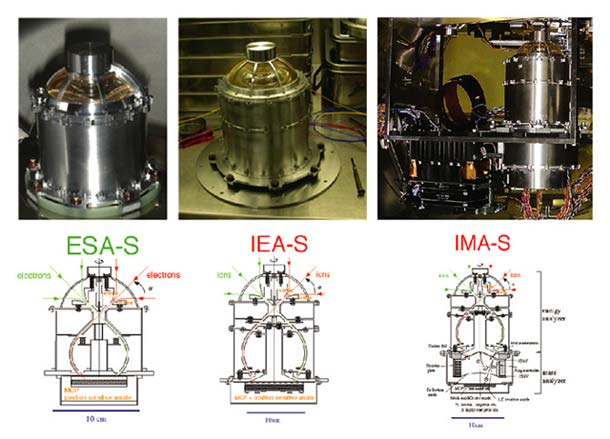LMAG and PACE enable us to study on the present and ancient (say, 3-4 billion years ago) environment of magnetic fields and plasma on and around the Moon and also on the evolution of its deep interior.
PACE consists of 4 sensors: ESA (Electron Spectrum Analyzer)-S1, ESA-S2, IMA (Ion Mass Analyzer), and IEA (Ion Energy Analyzer). ESA-S1 and S2 measure the three-dimensional distribution function of low energy electrons below 15 keV, while IMA and IEA measure the three-dimensional distribution function of low energy ions below 28 keV/q.

PACE sensors are top hat type electrostatic analyzers with angular scanning deflectors at the entrance and toroidal electrodes inside. IEA-S and IMA-S have additional electrodes that are used for controlling sensitivity electrically. In order to measure ion mass, LEF (Linear Electric Field) TOF (Time Of Flight) ion mass analyzer is attached to IMA.
Sputtered ions from the lunar surface
Sputtered ions from the lunar surface will be measured for the first time. Recently, ground-based observations have revealed the existence of tenuous alkali-atmosphere around the moon. The rarefied atmosphere is thought to be produced mainly by solar photons and the solar wind.
Sputtering by the solar wind that is one of the source mechanisms of the tenuous atmosphere presumably produces the secondary ions reflecting the composition of the lunar surface.
Major Specification
| Plasma observation (PACE) |
Energy range | 5eV-15keV(ESA) 5eV/q-28keV/q(IEA,IMA) |
|---|---|---|
| Angular resolution | 5 degrees x 8 degrees (ESA) 5 degrees x 5degrees (IEA) 5degrees x5 degrees(IMA) |
|
| Sampling interval | 1 sec |

Yoshifumi Saito
Department of Space Plasma Physics,
JAXA / ISAS